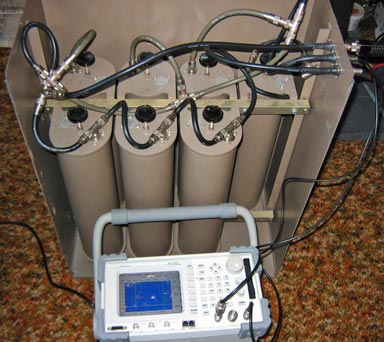 |
| United We Stand |
|
|
Brainerd Area Amateur Radio Club |
|
Crosslake Repeater Improved February 2, 2008 |
 Report
from Roger WØWUG's on work on the BAARC 147.030
MHZ+ Repeater (Roger was assisted by WØRC)
Report
from Roger WØWUG's on work on the BAARC 147.030
MHZ+ Repeater (Roger was assisted by WØRC)
In early December, I contacted Lloyd Bottin, sales engineer for Melby Communications, Inc, based in Lakefield, MN , near the Iowa border, about the possibility of borrowing a communications service monitor with RF tracking generator/spectrum analyzer capability. It was necessary to have precise frequency accuracy to be able to tune the duplexer cavities to the exact frequency of the receiver and transmitter in the repeater.
Some background information on Melby Communications: I have been purchasing communications test equipment from Melby Comm since the 1970's for my own business and the Willmar Technical College, when the company was owned by Chuck Melby. Lloyd Bottin now owns the business, but it retains the original name.
They are factory representatives for the IFR brand communications test sets, and a few years ago IFR merged with another company named Aeroflex. Lloyd generously agreed to let me use a demo model IFR2975 digital service monitor for dialing-in the duplexer. On one of his sales trips across the state he dropped the machine off at my house. With his help we set up a test routine menu for our duplexer, to save time in using the instrument.
I have only been away from my communications lab at Ridgewater College in Willmar for seven years, but wow, has test equipment ever changed since then! Gone are the microprocessor-assisted analog "boxes." The 2975 is essentially a computer that acts like a service monitor. Everything is menu driven, and learning where-to-find-what-function in the menu directory would have taken a lot of time. That's why we set up and stored a test routine for "sweeping" our duplexer. I knew what I needed the “box” to do, and Lloyd located the functions in the various menus, we set parameters, and then they were stored to memory to recall later.
Most everything you do with the instrument is controlled by computer "mouse clicks." Front panel push buttons are actually "soft-keys" that bring up various menus. Compounding the learning curve is that this instrument is capable of generating, decoding, and analyzing most modes of digital two-way radio, such as the so-called APCO-P25 trunking radio system protocol as used by most "metro" law enforcement and public safety organizations currently--plus many other modes of narrow-band digital radio modulation. The price? Roughly $18,000.00 and up, depending on options.
The duplexer for the Crosslake repeater was originally designed for use in
the 154MHz public safety two- way radio spectrum. Moving it down to 147Mhz is
more involved than just making "tweaking" (tuning) adjustments. Although it did
tune down to 147MHz, its operation was very "lossy" and performed poorly. I
recalled that many years ago I rebuilt a similar duplexer for a ham radio
repeater in Willmar. I tracked down the location of the coax wiring harness and
correct coupling loops to my former lab at Ridgewater College. The instructor
(former student of mine!) agreed to let us have the harness, to be replaced with
the one that came with our Club's duplexer. It
probably took less than an hour to transplant coax harnesses and retune using
the 2975. I found that the duplexer has better rejection with 3 cavities on each
side, as a bonus, instead of four. That leaves
two cavity filters that could be used for some other club project.
With Al (WØRC) Doree's help in first removing the duplexer from the Crosslake
site and re-installing it, on-air.
QSO's indicate the 147.030 repeater is working as well as it can.
At Lloyd Bottin's request, I dropped the 2975 off at the Hennepin County Sheriff's Radio Dispatch Center near Hwy 169 and Rockford Road, Plymouth, on my way to Minneapolis for Christmas. Several of my former students work as technicians there, and it was fun talking with them again.
Roger WØWUG.
This page was last updated 02/02/2008 Ø